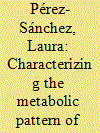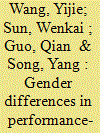| Srl | Item |
| 1 |
ID:
102629


|
|
|
|
|
| Publication |
New Delhi, Lok Sabha Secretariat, 2009.
|
| Description |
4p.
|
| Series |
Parliamentary procedure abstract series; 23
|
|
|
|
|
|
|
|
|
|
|
|
Copies: C:1/I:0,R:1,Q:0
Circulation
| Accession# | Call# | Current Location | Status | Policy | Location |
| 055706 | 328.404/IND 055706 | Main | On Shelf | Reference books | |
|
|
|
|
| 2 |
ID:
162900


|
|
|
|
|
| Summary/Abstract |
The extreme degree of openness of contemporary urban systems with regard to both economy and population creates a serious challenge for the study of urban energy metabolism. A novel tool based on Multi-Scale Integrated Analysis of Societal and Ecosystem Metabolism (MuSIASEM) is proposed to overcome these challenges. It consists of an end-use matrix, a coherent multi-level integrated characterization of the uses of different forms of energy carriers (electricity, heat, fuels) for the various tasks performed in the city, including private and public mobility, tourism, commercial and residential activities. The end-use matrix integrates quantitative data referring to different dimensions (i.e. energy, human activity, land use, value added) and hierarchical (economic sectors and functional elements at lower levels) and spatial scales (i.e. individual buildings, neighborhoods, and the city as a whole). The end-use matrix provides information on both extensive (flows) and intensive variables (flow/fund ratios or benchmarks). Benchmarks are important for policy-making and allow a meaningful comparison of energy performance across hierarchical levels within the urban system, and among different urban systems. The approach is illustrated for Barcelona, a global city characterized by an important service sector.
|
|
|
|
|
|
|
|
|
|
|
|
|
|
|
|
| 3 |
ID:
149764


|
|
|
|
|
| Summary/Abstract |
We examined gender differences in performance-based pay in an institute of a top Chinese university, to provide insight into the gender earnings gap. We found that male professors earned more from research and less from teaching than did comparable female professors even though male and female professors showed no statistically significant difference in the total performance-based pay. Given the piece rate nature of bonuses in the institute and one's tendency to invest more time in areas where one has comparative advantages to maximize the total income, the study results lead to the conclusion that male professors displayed comparative advantage in research while female professors exhibited comparative advantage in teaching. The conclusion is corroborated by analyses of time allocation, and number of papers published as first author and as co-author.
|
|
|
|
|
|
|
|
|
|
|
|
|
|
|
|